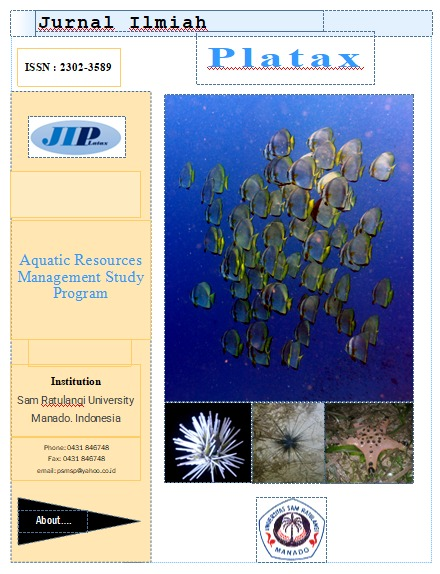Sediment Transport and Economic Social Effect of Bowone People Mining Sangihe Islands Regency
DOI:
https://doi.org/10.35800/jip.v11i2.48734Keywords:
sediment transport;, socio-economic impact;, people's mine;, Bowone village;, Sangihe Islands;Abstract
This study aims to determine the magnitude of the sedimentation rate and the prediction of sediment transport in Binebas Bay as the scope of the Bowone people's mine run-off disposal area, as well as the socio-economic impacts on the community and especially for fishermen. Sediment diameter measurements were carried out by taking sediment samples at each station using a sediment trap. Sediment traps made of pipes will be installed at each station and the height of the sediment will be measured using a ruler every 2 weeks for 3 months. The research data were analyzed using the comparative method, namely the results of measuring the sediment rate in the field compared to the calculation results according to Engelund. The sediment rate in the waters of Binebas Bay which is close to the people's mining in Bowone Village is 0,058943 m3/year. Sediment transport in the waters of Binebas Bay is m3/m*s. Sedimentation is still relatively low (small) in the waters of Binebas Bay. Socially, people's mining activities in Kampung Bowone have a positive impact where there is the availability of employment opportunities for the community. Economically, people's mining activities increase people's income. However, the negative impact is environmental damage.
Keywords: sediment transport; socio-economic impact; people's mine; Bowone village; Sangihe Islands
Abstrak
Penelitian ini bertujuan untuk mengetahui besarnya laju sedimentasi dan prediksi transport sedimen di Teluk Binebas sebagai lingkup wilayah buangan run-off tambang rakyat Bowone, serta dampak sosial ekonomi bagi masyarakat dan khususnya bagi nelayan. Diameter sedimen diukur dengan mengambil sampel di tiap Stasiun. Perangkap sedimen dibuat dari pipa dan diukur tinggi sedimennya tiap 2 minggu selama 3 bulan. Data penelitian dianalisis kemudian dilakukan komparasi antara hasil pengukuran laju sedimentasi di lapangan dengan hasil perhitungan transportasi sedimen menurut Metode Engelund. Laju sedimen di perairan Teluk Binebas yang dekat dengan pertambangan rakyat Kampung Bowone yaitu sebesar 0,058943 m3/ tahun. Transpor sedimen di perairan Teluk Binebas yaitu m3/m*s. Sedimentasi masih tergolong rendah (kecil) di perairan Teluk Binebas. Secara sosial, kegiatan pertambangan rakyat di Kampung Bowone memberikan dampak yang positif dimana terdapat ketersediaan lapangan kerja bagi masyarakat. Secara ekonomi, kegiatan pertambangan rakyat meningkatkan pendapatan masyarakat. Namun, dampak negatifnya adalah kerusakan lingkungan.
Kata kunci: transport sedimen; dampak sosial ekonomi; tambang rakyat; kampung bowone; kepulauan sangihe
References
Astuti, E. H., Ismanto, A., & Saputro, S. 2016. Studi Pengaruh Gelombang terhadap Transport Sedimen di Perairan Timbulsloko Kabupaten Demak Jawa Tengah. Jurnal Oseanografi, 5(1): 77-85
Coastal Engineering Manual .2001. Fundamental of Design: US Army Corps of Engineers
Das, B. M., Endah, N., & Mochtar, I. B. 1995. Mekanika Tanah (Prinsip – Prinsip Rekayasa Geoteknis). Erlangga: Jakarta
Dwianti, R. F., Widada, S., & Hariadi. 2017. Distribusi Sedimen Dasar di Perairan Pelabuhan Cirebon. Jurnal Oseanografi, 6(1): 228-235
Hidayat, dkk. 2014. Analisis Laju Sedimentasi di Daerah Padang Lamun dengan Tingkat Kerapatan Berbeda di Pulau Panjang, Jepara. Diponegoro Journal of Maquares, Management of Aquatic Resources, 3(3): 73-79
Kumaseh, E. I., Kaim, M. A., & Tatontos, Y. V. 2017. Laju Sedimentasi di Perairan Kampung Salurang Kabupaten Kepulauan Sangihe. Jurnal Ilmiah Tindalung, 3(2): 49-54
Kumaseh, E. I., Tatontos, Y. V., & Sarapil, C. I. 2020. Prediksi Transpor Sedimen di Perairan Teluk Tahuna Kabupaten Kepulauan Sangihe. Journal of Marine Research, 9(3): 207-214
Manoppo, Lefrand. 2014, “Optimalisasi Pengelolaan Sumberdaya Ikan Selar (Selaroides Leptolepis) Melalui Penguatan Kearifan Lokal Melombo di desa Salurang Kabupaten Kepulauan Sangihe”, Program Pascasarjana, Fakultas Pertanian, Universitas Brawijaya, Malang.
Pratama, M. I., Legono, D., & Rahardjo, A. P. 2019. Analisis Transpor Sedimen serta Pengaruh Aktivitas Penambangan pada Sungai Sombe, Kota Palu, Sulawesi Tengah. Jurnal Teknik Pengairan, 10(2): 84-96
Romdania, Y. 2010. Analisis Kasus Sedimentasi di Tiga Titik Kawasan Water Front City. Jurnal Rekayasa, 14(1): 57-66
Rukmana, A. Y., Ikhsan, J., & Harsanto, P. 2017. Pengukuran Angkutan Sedimen Dasar pada Aliran Sungai Progo menggunakan Alat Helley Smith (Titik Tinjauan Sungai Progo di Jembatan Kebon Agung I dan Kebon Agung II). Tugas Akhir. Jurusan Teknik Sipil Fakultas Teknik Universitas Muhammadiyah Yogyakarta
Setiana, Nelli & Syahnur, Sofyan. 2018. Dampak Pertambangan Emas terhadap Kehidupan Sosial Ekonomi dan Lingkungan Masyarakat di Kecamatan Beutong Kabupaten Nagan Raya. Jurnal Ilmiah Mahasiswa (JIM) Ekonomi Pembangunan Fakultas Ekonomi dan Bisnis Unsyiah, 3(4): 584 – 594
Sudira, I W., Mananoma, T., & Manalip, H. 2013. Analisis Angkutan Sedimen pada Sungai Mansahan. Jurnal Ilmiah Media Engineering, 3(1): 54-57
Sudiyarti, N., Fitriani, Y., & Jusparnawati. 2021. Analisis Dampak Sosial Ekonomi Keberadaan Tambang Emas Rakyat terhadap Masyarakat Desa Lito. Jurnal Ekonomi & Bisnis, 9(2): 152 – 160
Suntoyo. 2014. Mekanika dan Teknologi Transportasi Sedimen. Jurusan Teknik Kelautan Fakultas Teknologi Kelautan Institut Teknologi Sepuluh Nopember: Surabaya
Triatmodjo, B. 1999. Teknik Pantai. Beta Offset: Yogyakarta
Triyatno. 2014. Transportasi Sedimen Pantai Padang Sumatera Barat. Jurnal Geografi, 3(2): 77-84
Wisha, U. J., & Gemilang, W. A. 2019. Estimasi Transpor Sedimen di Perairan Kecamatan Brebes, Jawa Tengah Berdasarkan Laju Sedimentasi dan Pendekatan Model Numerik. Jurnal Geologi Kelautan, 17(1): 49-62
Downloads
Published
How to Cite
Issue
Section
License
Copyright (c) 2023 Eunike Irene Kumaseh, Costantein Imanuel Sarapil, Ganjar Ndaru Ikhtiagung

This work is licensed under a Creative Commons Attribution-NonCommercial 4.0 International License.
COPYRIGHT
Authors who publish with this journal agree to the following terms:
Authors hold their copyright and grant this journal the privilege of first publication, with the work simultaneously licensed under a Creative Commons Attribution License that permits others to impart the work with an acknowledgment of the work's origin and initial publication by this journal.
Authors can enter into separate or additional contractual arrangements for the non-exclusive distribution of the journal's published version of the work (for example, post it to an institutional repository or publish it in a book), with an acknowledgment of its underlying publication in this journal.
Authors are permitted and encouraged to post their work online (for example, in institutional repositories or on their website) as it can lead to productive exchanges, as well as earlier and greater citation of the published work (See The Effect of Open Access).




















